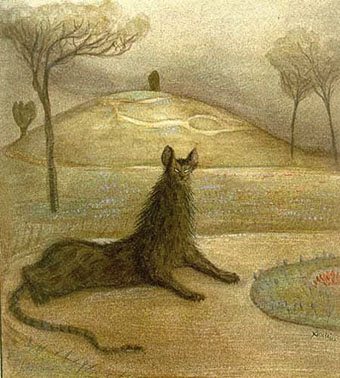Dream Animal (1903) by Alfred Kubin.
• The week in Finland: A set of Finnish emojis includes icons for notable cultural exports such as Tom of Finland and Moominmamma. Tove Jansson’s creations have received fresh attention this month with the debut release of the electronic soundtrack music for The Moomins, an animated TV series made in Poland in 1977, and first broadcast in the UK in 1983. Andrew Male talked to Graeme Miller and Steve Shill about creating Moomins music with rudimentary instrumentation.
• Russian company Mosfilm has made a new copy of Andrei Tarkovsky’s science-fiction masterpiece, Stalker (1979), available on their YouTube channel. Tarkovsky’s films have been blighted by inexplicable flaws in their home releases, as Stalker was when reissued on a Region B Blu-ray last year. The new Mosfilm upload looks better than my old DVD so for the moment this is the one I’ll be watching.
• Before straight and gay: the discreet, disorienting passions of the Victorian era. Deborah Cohen reviews A Very Queer Family Indeed by Simon Goldhill. Related: Kevin Killian reviews Murder in the Closet: Essays in Queer Clues in Crime Fiction Before Stonewall, edited by Curtis Evans.
• “How many graphic designers owe their introduction to typography to a teenage encounter with the typefaces and lettering found on album covers?” asks Adrian Shaughnessy.
• Mixes of the week: Secret Thirteen Mix 210 by Ascion, FACT Mix 587 by Seekersinternational, and The Séance, 4th February 2017.
• Pankaj Mishra on Václav Havel’s lessons on how to create a “parallel polis”. Related: The Power of the Powerless by Václav Havel.
• Hans Corneel de Roos on Dracula‘s lost Icelandic sister text: How a supposed translation proved to be much more.
• “I live outside the world in a universe I myself have created, like a madman or a holy visionary.” — Michel de Ghelderode.
• The Metropolitan Museum of Art makes 375,000 images of public art freely available under Creative Commons Zero.
• Richard H. Kirk on Thatcherite pop and why Cabaret Voltaire were like The Velvet Underground.
• Emily Gosling on what David Lynch’s use of typography reveals (or doesn’t).
• White Noise Sounds of Frozen Arctic Ocean with Polar Icebreaker Idling.
• John Gray on what cats can teach us about how to live.
• At Dennis Cooper’s: Day of the Mellotron (Restored).
• The Warburg Institute Iconographic Database.
• Sastanàqqàm by Tinariwen.
• Tanz Der Vampire (1969) by The Vampires of Dartmoore | Dracula (1983) by Dilemma | Vampires At Large (2012) by John Zorn


I’m hoping Mosfilm is eventually planning to issue the restored STALKER on some hardcopy format.
It’s interesting that even though the Strugatskys were involved in the script, the plot of the movie is so substantially revised from the novel ROADSIDE PICNIC that someone could go back to the source material and make a completely different movie. It wouldn’t be a “remake” at all. But could a contemporary filmmaker resist the temptation to turn it into a CGI fest? It would help if, like Tarkovsky, they had other concerns than special effects.
I think Mosfilm licences their films rather than sells them outright. At the moment it’s Curzon in the UK that have the rights to the Tarkovsky catalogue but Criterion UK are also going to be doing Solaris in the near future. If they do then there’s a chance we may see a similar release of Stalker.
Tarkovsky’s diaries don’t say much about Stalker, unfortunately, so I’m also in the dark about the degree of involvement from the Strugatskys. The obvious thing is that even though they’re credited with the script, the entire thing is typical Tarkovsky from start to finish, down to the endless philosophical discussions and poetry quotations. There’s nothing like that in the novel, and also little of the novel’s Zone-ness in the film. I don’t mind that since both works have their own distinct qualities.
Thanks for the heads up about Stalker. Thrilled to discover Mosfilm have HD versions of his other films too (unfortunately not all seem to be subtitled).